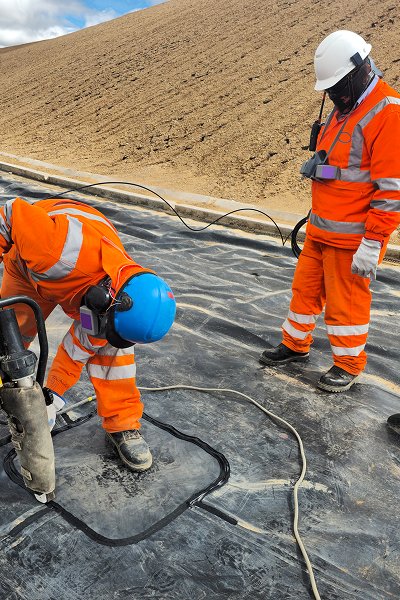What is bentonite clay liner ?
Bentonite Clay Liner (GCL for short) is a prefabricated composite anti-seepage material, which is widely used in landfills, tailings ponds, water conservancy projects, artificial lakes and other projects that require anti-seepage. It uses bentonite as the core water-absorbing and swelling material, and is compounded with materials such as geotextiles or geomembranes. It has excellent anti-seepage performance, self-healing ability and convenient construction. It is an important choice to replace traditional clay liners in modern environmental protection projects.

Basic structure of bentonite liner
Bentonite liner usually consists of three layers:
Upper geotextile: mostly non-woven fabric, used to protect the middle bentonite layer and enhance tensile strength.
Middle bentonite layer: mainly sodium-based bentonite, which can swell rapidly when exposed to water to form a low-permeability gel barrier.
Lower geotextile or membrane: usually woven geotextile or PE membrane, used to enhance mechanical strength and support the overall structure.
Characteristics of bentonite clay liner materials
Bentonite is a natural clay containing a large amount of montmorillonite minerals, with the following unique properties:
High expansion: After absorbing water, the volume can expand 5~15 times, blocking the soil pores.
Low permeability: The permeability coefficient of the formed colloidal layer can be as low as 1×10⁻⁹ cm/s, which is close to or better than compacted clay.
Strong self-healing ability: When slightly damaged, bentonite can expand and block the gaps when it encounters water, restoring the anti-seepage effect.
Chemical compatibility: It has strong impermeability to a variety of organic matter, heavy metal ions, and acid and alkali liquids (depending on the specific composition).
Advantages of bentonite liner
Compared with traditional compacted clay layer, bentonite liner has the following significant advantages:
Simple and fast construction: just lay it, no complicated compaction process is required.
Space saving: The thickness is only 610mm, which is much smaller than the traditional clay layer (usually 0.51m), which can effectively save landfill capacity.
Stable and reliable performance: even in long-term burial and harsh environment, it can maintain stable low permeability.
Adapt to complex terrain: good flexibility, can be laid in irregular or sloped areas according to the terrain.
Self-healing function: small area damage can be automatically repaired by swelling in water, reducing the risk of leakage.
Application scenarios
Bottom anti-seepage system
GCL is often used in the bottom liner system of landfills, acting as the first or second anti-seepage barrier. When used in conjunction with HDPE membrane, it forms a double anti-seepage protection structure. Its main functions include:
Preventing leachate from penetrating downward;
When the membrane is damaged, the bentonite automatically expands to fill the hole and has self-healing ability;
Reducing the risk of groundwater pollution.

Tailings ponds and mine waste dumps
Tailings ponds contain a large amount of toxic substances such as heavy metals, acidic water, and chemical residues, which will cause serious surface and groundwater pollution after leakage. GCL has strong resistance to chemical erosion and can still maintain low permeability in acidic, alkaline and some heavy metal solutions. Therefore, it is widely used in:
The bottom of the tailings dump is waterproof;
The liquid isolation layer of the heap leaching site;
The reclamation and closure covering system.

Fusion application of GCL and other anti-seepage materials
With the increase of engineering needs, GCL is often used in combination with other materials (such as HDPE geomembrane) to form a "composite liner system". For example, the common double-layer anti-seepage system includes:
One layer of GCL + one layer of HDPE membrane: improve the overall anti-seepage level, GCL provides self-healing and leak-proofing functions, and the membrane layer is responsible for the first barrier;
GCL + drainage layer + protective layer: constitute a complete landfill bottom structure, improve structural stability and system life.
Summary
Excellent anti-seepage performance; GCL relies on the expansion and water absorption of sodium-based bentonite after it comes into contact with water, which can automatically fill the gaps formed in the fine cracks of the structure, effectively preventing the infiltration of leachate, and playing an extremely critical role in ensuring the safety of soil and groundwater.
Outstanding self-healing ability; compared with the "leakage at the first break" of traditional HDPE membrane materials, GCL can achieve a certain degree of self-healing function through the bentonite re-expansion mechanism after slight damage, greatly improving the system's fault tolerance and service life.
Convenient and efficient construction; GCL coils are easy to lay, light in weight, and fast in construction, which can significantly shorten the construction period and reduce labor costs, and adapt to complex terrain such as slopes, corners, foundation pits, etc., greatly improving construction flexibility.
Adapt to the needs of multiple scenarios; whether it is a domestic waste landfill, a hazardous waste dump, or a tailings pond, a reservoir, an artificial lake, an underground structure anti-seepage system, etc., GCL has shown strong adaptability and has become a well-deserved "all-round" anti-seepage material.
Environmentally friendly and sustainable; GCL is essentially a non-toxic and harmless mineral material, with little impact on the environment during production and use, and will not cause long-term pollution risks after the site is closed. It is a representative of environmentally friendly building materials that conforms to the green and low-carbon concept.


